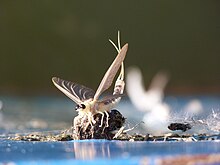Palingenia_longicauda
Palingenia longicauda
Species of mayfly
You can help expand this article with text translated from the corresponding article in French. (July 2023) Click [show] for important translation instructions.
|
Palingenia longicauda is an aquatic insect in the order Ephemeroptera. It is known as the Tisa or Tisza mayfly after the European Tisza river where it is found and also as the long-tailed mayfly and giant mayfly since it is the largest mayfly species in Europe, measuring 12 cm (4.7 in) from head to tail.[1][2]
Unlike many other species of mayflies, adult P. longicauda never move away from water; they fly low and their cerci are frequently touching or sweeping the surface.[3] The slow-moving river and absence of surface-feeding fish help make this possible.[2] The presence of P. longicauda is an indicator of clean unpolluted water. Now extinct in many European countries, it can be found on the Tisza river (in Slovakia, Serbia and Hungary),[1] on the Prut and Bega (in Romania)[4] and on Ukrina (in Bosnia and Herzegovina).
